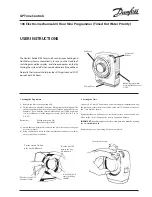
T
imers
PRECAUTIONS IN USING S1DXM-A/M AND S1DX
Applicable standard
PRECAUTIONS IN USING S1DXM-A/M AND S1DX
Safety standard
EN61812-1
Pollution Degree 2/Overvoltage Category II (2 Form C type)
Pollution Degree 1/Overvoltage Category II (4 Form C type)
EMC
(EMI)EN61000-6-4
Radiation interference electric field strength
Noise terminal voltage
(EMS)EN61000-6-2
Static discharge immunity
RF electromagnetic field immunity
EFT/B immunity
Surge immunity
Conductivity noise immunity
Power frequency magnetic field immunity
Voltage dip/Instantaneous stop/Voltage fluctuation immunity
EN55011 Group1 ClassA
EN55011 Group1 ClassA
EN61000-4-2 4 kV contact
8 kV air
EN61000-4-3 10 V/m AM modulation (80 MHz to 1 GHz)
10 V/m pulse modulation (895 MHz to 905 MHz)
EN61000-4-4 2 kV (power supply line)
1 kV (signal line)
EN61000-4-5 1 kV (power supply line)
EN61000-4-6 10 V/m AM modulation (0.15 MHz to 80 MHz)
EN61000-4-8 30 A/m (50 Hz)
EN61000-4-11 10 ms, 30% (rated voltage)
100 ms, 60% (rated voltage)
1,000 ms, 60% (rated voltage)
5,000 ms, 95% (rated voltage)
Reset periods
After unscheduled operations have been
completed, or if the timer operation power
supply has been turned off at any time
during operation, a reset period of at
least 0.1 seconds should be allowed
before resuming operation.
External surge protection
External surge protection may be
required if the following values are
exceeded. Otherwise, the internal circuit
will be damaged. The typical surge
absorption elements include a varistor, a
capacitor, and a diode. If a surge
absorption element is used, use an
oscilloscope to see whether or not the
foreign surge exceeding the specified
value appears.
Single-pole, full-wave voltage for surge
waveform [
±
(1.2
×
50)
µ
s]
Since the main body cover and knob are
made of polycarbonate resin, prevent
contact with organic solvents such as
methyl alcohol, benzine and thinner, or
strong alkali materials such as ammonia
and caustic soda.
Terminal wiring
Make sure that terminals are wired
carefully and correctly, referring to the
terminal layout and wiring diagrams.
Particularly, since the DC type has
polarity, do not operate it with reverse
polarity.
Assembly
1) When installing, use a terminal socket
or socket intended for HC/HJ relay. For
adjacent installations, be sure to first
verify the installation conditions of the
terminal sockets or sockets you will be
using.
2) Use the separately-sold dedicated
socket leaf holding clip to secure terminal
sockets and sockets to the timer unit. The
conditions of use for dedicated socket
leaf holding clip will differ depending on
the terminal socket or socket you will be
using. Therefore, please test under actual
conditions before putting into operation.
3) If terminals are to be soldered directly,
please hand solder with a 30 to 60 W
solder iron with a tip temperature of
300
°
C for no more than 3 seconds.
Automatic soldering should be avoided.
4) A flux-tight construction is not used
with this timer, so be careful that flux or
cleaning fluid does not get inside the
case.
5) To assure that characteristics are
maintained, do not remove the case.
Long Continuous Current Flow
Long continuous current flow through the
timer cause generation of heat internally,
which degrade the electronic parts. Use
the timer in combination with a relay and
avoid long continuous current flow
through the timer. (Refer to the circuit
diagram below when using a safety
circuit for continuous operation.)
Phase synchronization using AC
load
If the turning on of the timer output relay
is synchronized to the AC power supply
phase, there may be times when the
service life is shortened because of
electrical factors, or when a locking
phenomenon (defective relay return)
occurs because of contact point welding
or a shift in the contact relay. Check the
operation using the actual timer.
Acquisition of CE marking
Please abide by the conditions below
when using in applications that comply
with EN61812-1.
1) Overvoltage category II,
pollution degree 2 (2 Form C type)
Overvoltage category II,
pollution degree 1 (4 Form C type)
2) The load connected to the output
contact should have basic insulation.
This timer is protected with basic
insulation and can be double-insulated to
meet EN/IEC requirements by using
basic insulation on the load.
3) Please use a power supply that is
protected by an overcurrent protection
device which complies with the EN/IEC
standard (example: 250 V 1 A fuse, etc.).
4) You must use a terminal socket or
socket for the installation. Do not touch
the terminals or other parts of the timer
when it is powered. When installing or un-
installing, make sure that no voltage is
being applied to any of the terminals.
5) Do not use this timer as a safety
circuit. For example when using a timer in
a heater circuit, etc., provide a protection
circuit on the machine side.
Operation voltage
Surge voltage
100 to 120V AC, 200 to 220V AC
4,000V
12V DC, 24V DC
1,000V
100
90
50
30
0
0
1.2
50
Time (
µ
s)
Peak
Surge v
oltage (%)
R
T
R
T
R
All Rights Reserved © C
OPYRIGHT
Panasonic Electric Works Co., Ltd.





























